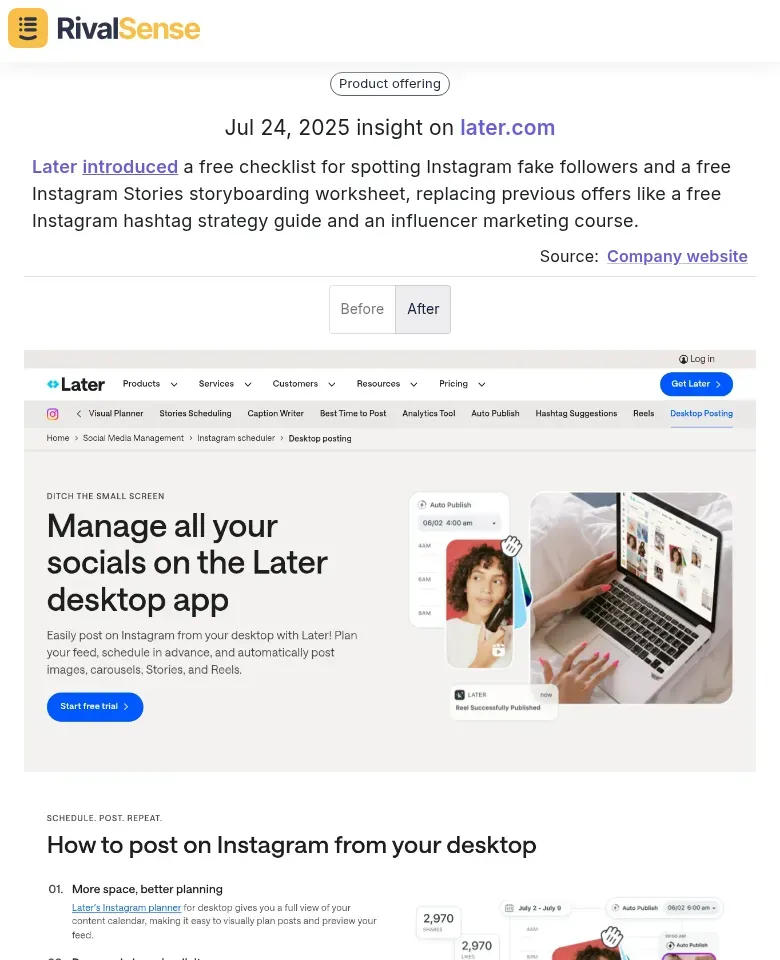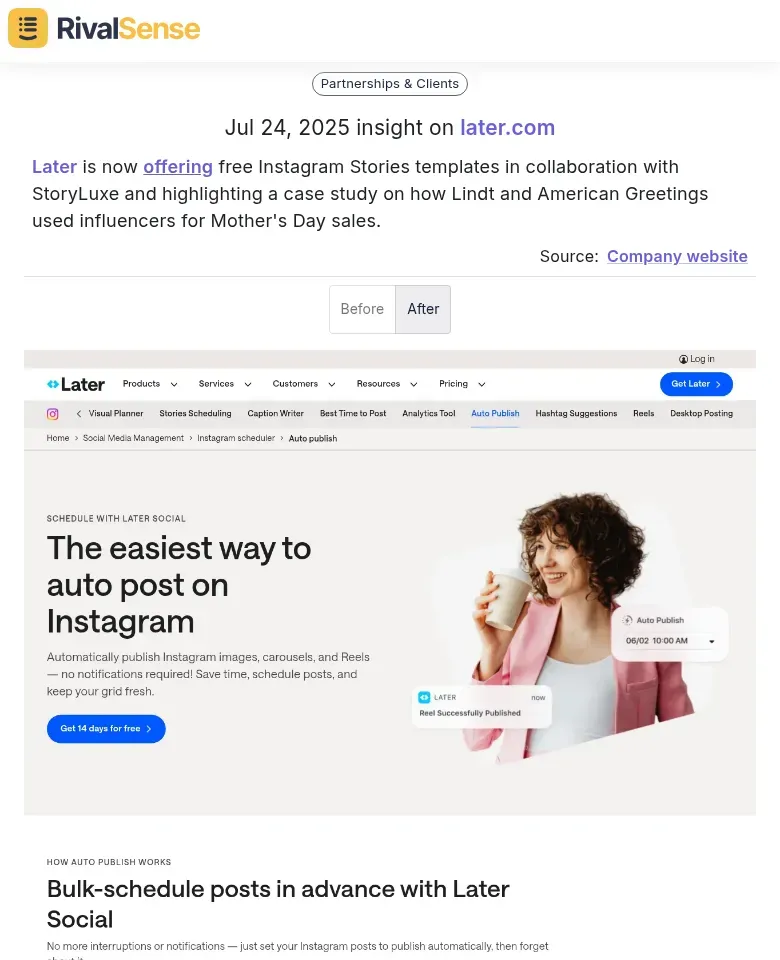Competitor Hiring Trends Tracking Cheat Sheet for Electricians
Tracking competitor hiring trends isn't just about keeping tabs on the competition—it's a strategic advantage that can transform your electrical business operations. Understanding where competitors invest in talent reveals their priorities and helps you anticipate market shifts. Here's why it matters:
Talent Acquisition Intelligence
When competitors actively recruit master electricians or specialized technicians (solar, industrial automation), they're signaling market demand. This insight helps you:
- Adjust your compensation packages preemptively
- Target similar talent pools before they're depleted
- Identify skill gaps your competitors are addressing
Market Expansion Signals
Hiring patterns reveal geographic and service expansion plans:
- New hires in different zip codes = territorial expansion
- Recruiting HVAC technicians = potential service diversification
- Commercial project managers = shift toward larger contracts
Scaling and Pivot Detection
Monitor these hiring indicators:
- Rapid scaling: 3+ similar roles posted within 30 days
- Service pivots: New specialist roles (EV charging, smart home tech)
- Financial health: Consistent hiring vs. sudden recruitment freezes
Actionable Tracking Steps:
- Set Google Alerts for "[Competitor Name] + hiring + electrician"
- Monitor LinkedIn job postings weekly
- Track Indeed/Glassdoor listings for salary benchmarking
- Note job posting frequency and urgency language
- Cross-reference hiring with competitor project announcements
By systematically tracking these patterns, you'll anticipate market shifts, optimize your hiring strategy, and position your electrical business ahead of competitive moves.
Key Hiring Metrics to Monitor in Electrical Contractor Competitors
Tracking your electrical contractor competitors' hiring patterns reveals critical market intelligence that can shape your recruitment strategy and business positioning. Consistent monitoring helps identify emerging trends before they impact your operations. Here are the essential metrics to monitor:
Job Posting Analytics
• Track posting frequency on Indeed, LinkedIn, and local trade boards weekly
• Monitor job volume spikes that may indicate competitor expansion or high turnover
• Note seasonal hiring patterns (summer construction peaks vs. winter maintenance focus)
• Use Google Alerts for competitor company names + "hiring" or "jobs"
Compensation Intelligence
• Document salary ranges for apprentices, journeymen, and master electricians
• Track benefit packages: health insurance, retirement plans, tool allowances
• Monitor sign-on bonuses and retention incentives
• Compare hourly vs. salary structures across competitors
Specialization Priorities
• Identify which certifications competitors value most (OSHA 10/30, NFPA 70E, Arc Flash)
• Track demand for specializations: industrial, residential, commercial, renewable energy
• Monitor requirements for specific skills: PLC programming, motor controls, smart home technology
• Note apprenticeship program partnerships with trade schools
Quick Action Steps:
- Create a monthly tracking spreadsheet with competitor names and metrics
- Set up job board alerts for your top 5 competitors
- Screenshot compensation details before postings expire
- Cross-reference hiring trends with local construction permits to predict market demand
This intelligence helps you adjust your own hiring strategy, compensation packages, and training programs to stay competitive.
Where to Find Competitor Hiring Intelligence
Finding reliable sources for competitor hiring intelligence is essential for effective tracking. Leveraging multiple channels ensures comprehensive coverage of your competitors' recruitment activities. Here are the most productive sources:
LinkedIn Company Pages and Employee Movement Tracking
Start by following your top 3-5 local competitors on LinkedIn. Set up weekly alerts for their company page updates and monitor their "People" tab for new hires. Use LinkedIn's "People You May Know" feature to spot when employees move between electrical companies in your area.
Quick checklist:
- ✅ Save competitor profiles and check monthly for headcount changes
- ✅ Track job titles being hired (apprentices vs. journeymen vs. project managers)
- ✅ Note hiring frequency patterns (seasonal spikes, project-based recruitment)
Industry Job Boards and Trade-Specific Platforms
Monitor specialized platforms like ElectricalJobs.com, IBEW job boards, and local trade association websites. Set up Google Alerts for "electrician jobs + [your city]" to catch postings across multiple platforms.
Action steps:
- 📌 Bookmark 5-7 relevant job boards and check bi-weekly
- 📌 Screenshot competitor job postings to track wage ranges and benefits
- 📌 Note required certifications and specializations they're seeking
Local Permit Applications and Contractor Licensing Databases
Most municipalities publish contractor permit data online. Large projects requiring multiple electricians often appear in these databases 30-60 days before hiring begins.
Pro tip: Cross-reference permit data with LinkedIn hiring activity. If a competitor pulls permits for a major commercial project but isn't actively hiring, they may be planning to subcontract – creating potential partnership opportunities for your business.
Analyzing Competitor Hiring Patterns for Strategic Insights
Understanding your competitors' hiring patterns reveals strategic moves before they become market realities. This analysis transforms raw data into actionable business intelligence. Here's how to decode these signals:
Seasonal Patterns & Project Cycles
- Monitor job postings for apprentices and journey-level electricians during spring (March-May) - indicates major project pipeline
- Track commercial vs. residential hiring ratios to identify market focus shifts
- Watch for temporary vs. permanent position patterns revealing project-based growth
Geographic Expansion Tracking
- Set up alerts for competitor job postings in new cities/regions
- Analyze office locations mentioned in job descriptions
- Note requirements for local licensing - signals serious expansion intent
- Track hiring for project managers in new territories (typically hired 3-6 months before crews)
Technology Adoption Indicators
- Monitor for IT specialist, software trainer, or digital coordinator roles
- Look for requirements mentioning specific software (ServiceTitan, FieldEdge, etc.)
- Track hiring for roles involving smart home, solar, or EV charging specializations
- Note emphasis on tablet/mobile device experience in field positions
Quick Action Checklist:
- 🔔 Set Google Alerts for "[Competitor Name] + electrician + hiring"
- 🔍 Check Indeed/LinkedIn weekly for new postings
- 📊 Document hiring surges by location and specialization
- 🔗 Cross-reference with competitor social media for project announcements
- 🎯 Adjust your own hiring strategy based on identified gaps or opportunities
This intelligence helps you anticipate market moves and position strategically ahead of competition.
Tools and Resources for Automated Competitor Hiring Tracking
Manual tracking can be time-consuming, but automation tools streamline competitor monitoring efficiently. Implementing these solutions saves hours while ensuring consistent data collection. Here are practical options:
Job Posting Aggregators & Monitoring Solutions
Set up automated alerts on Indeed, ZipRecruiter, and Glassdoor for competitor company names. Use Boolean search operators like "Company A OR Company B electrician" to capture all relevant postings. Tools like JobSeer and Owler provide dedicated competitor job posting tracking with email notifications.
Social Media Monitoring for Recruitment Activity
Monitor competitors' LinkedIn company pages for new hire announcements and job postings. Use Hootsuite or Sprout Social to track hashtags like #hiring, #electrician, and #[CompetitorName]team. Set up Google Alerts for "[Competitor] hiring electrician" to catch press releases and news coverage.
Industry Databases & Trade Directories
Leverage NECA (National Electrical Contractors Association) and IBEW (International Brotherhood of Electrical Workers) membership directories to identify competitor workforce size changes. Check state licensing boards quarterly for new electrician certifications tied to competitor addresses.
Quick Setup Checklist:
- [ ] Create monitoring dashboard with 5-10 key competitors
- [ ] Set weekly email alerts for new job postings
- [ ] Track competitor headcount changes monthly
- [ ] Monitor salary ranges and benefit offerings
- [ ] Document hiring patterns by season/project type
Pro Tip: Cross-reference multiple data sources—if a competitor posts 3+ electrician jobs simultaneously, they likely won a major contract. This intelligence helps you identify market opportunities and adjust your own recruitment strategy accordingly.
Beyond Hiring: Why Tracking Competitor Content & Research Matters
While hiring insights are crucial, monitoring broader competitor activities provides a complete strategic picture. Content updates and research publications often signal market positioning shifts before operational changes occur. These real examples show how diverse intelligence drives decisions:
Example: Content Offer Evolution

Later introduced a free checklist for spotting Instagram fake followers and replaced older resources like hashtag guides.
Why it matters: Tracking content changes reveals how competitors educate customers and position expertise—valuable for electricians updating their service guides or training materials.
Example: Partnership-Driven Promotions

Later offered free Instagram Stories templates via StoryLuxe collaboration, highlighting influencer case studies.
Why it matters: Partnership announcements signal expansion into new customer segments—similar to electrical contractors collaborating with smart home brands to access premium clients.
Example: Research Publications

Gallup published research linking confidence in institutions to local roots.
Why it matters: Competitor studies reveal market analysis priorities—like electrical firms researching regional renewable energy adoption to guide expansion.
Turning Hiring Intelligence into Competitive Advantage
Collecting competitor hiring data is only valuable if you act on it decisively. Transforming insights into initiatives creates tangible business results. Implement these proven approaches:
Recruitment Strategy Adjustments:
• Monitor competitor job postings for salary ranges and adjust your offers by 5-10% above market rates
• Track their required skills and certifications to identify emerging industry standards
• Note their hiring locations to spot untapped talent pools in your area
• Analyze their job descriptions to refine your own employer branding messaging
Market Opportunity Identification:
• Create alerts for when competitors stop hiring in specific roles - signal potential service gaps
• Track hiring freezes or layoffs to identify clients who may need alternative service providers
• Monitor expansion hiring patterns to predict new market entries 6-12 months ahead
• Watch for specialized role postings (smart home tech, solar installation) indicating service diversification
Proactive Talent Pipeline Building:
• Build relationships with candidates before competitors start hiring for similar roles
• Create a "talent radar" spreadsheet tracking high-performers at competitor companies
• Develop apprenticeship programs in areas where competitors show consistent hiring struggles
• Partner with trade schools in regions where competitors are rapidly expanding
Quick Implementation Checklist:
□ Set up Google Alerts for "[Competitor Name] + electrician + hiring"
□ Weekly review of competitor job boards and LinkedIn company pages
□ Monthly analysis of hiring trends vs. your capacity planning
□ Quarterly strategy review based on competitive intelligence gathered
Remember: Act on insights within 2-4 weeks while opportunities remain fresh.
Ready to decode competitor moves before they happen?
Stop piecing together intelligence manually. With RivalSense, get automated weekly reports tracking competitor hiring, product launches, pricing changes, partnerships, and regulatory shifts—all in one digestible email.
👉 Try RivalSense free today and get your first competitor intelligence report instantly:
https://rivalsense.co/
📚 Read more
👉 How Glean's Healthcare Pivot Triggered Competitor Product Expansion
👉 Internet Research Workflow: Mining Competitor Knowledge Bases
👉 Step-by-Step: Track Carbon Removal Competitor Innovation Strategies
👉 Market Entry Competitor Intelligence Cheat Sheet for Business Leaders
👉 Oracle Overtakes SAP in ERP Revenue: Turning Market Shifts into Strategic Wins
